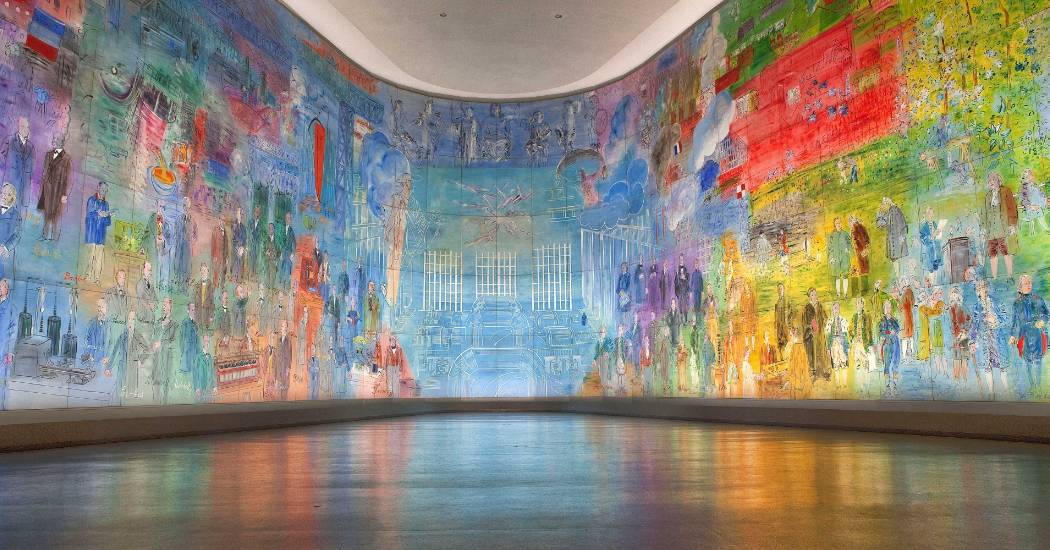
In late September, the Network of European Museum Organisations (NEMO) sent out an international survey in order to estimate the financial burden European museums are going to face due to rising energy costs. The answers provided by the museums to NEMO were discussed on 11 October, in Loule, Portugal, on their annual general meeting. Survey participation in Hungary was organized by the Pulszky Society. In order to quickly assess the situation, a survey was sent out to Hungarian museums and institutions, which was expected to be returned by 28 September. The aim of the brief English summary sent to NEMO was to provide a comprehensive picture on the impact of the energy crisis on Hungarian museums. The following document is a more detailed analysis based of survey results. The analysis represents the conditions from late September – early October period of the year.
A total of 125 answers were provided by 115 institutions (several institutions considered their various buildings and member institutions as separate entities).
The geographical distribution of the participants was relatively even, all Hungarian counties took part in the survey with at least two institutions. Their distribution per county is as follows:
• Heves County - 2
• Baranya County - 4
• Csongrád-Csanád County - 4
• Komárom-Esztergom County - 4
• Nógrád County - 4
• Tolna County - 4
• Vas County - 4
• Zala County - 4
• Békés County - 5
• Fejér County - 5
• Győr-Moson-Sopron County - 5
• Somogy County - 5
• Szabolcs-Szatmár-Bereg County - 5
• Hajdú-Bihar County - 7
• Jász-Nagykun-Szolnok County - 7
• Bács-Kiskun County - 9
• Veszprém County - 9
• Borsod-Abaúj-Zemplén County - 10
• Budapest - 14
• Pest County - 14
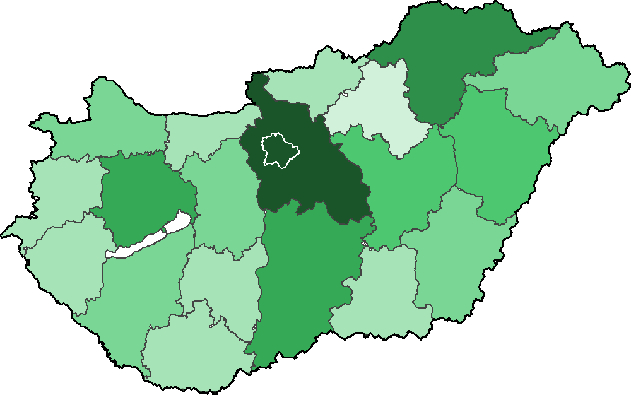
Map created by Regina Kalló
Based on maintainers and classifications, all types of institutions took part in the survey.
Distribution based on the type of maintainer:
• municipality: 75% (93)
• government: 2% (15)
• church: 5% (6)
• corporation: 6% (8)
• foundation: 2% (3)
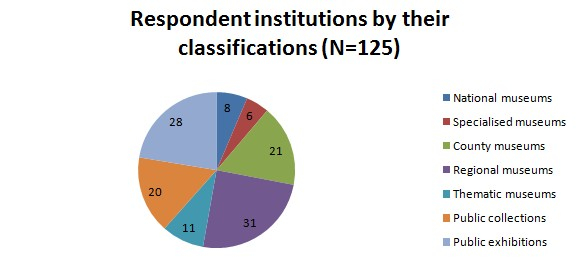
Pic created by Jozsef Antal
Distribution based on professional classification, in order of number of respondents:
• regional museums: 25% (31)
• public exhibitions: 22% (28)
• county museums:17% (21) (15 institutions, including member institutions)
• public collections: 16% (20)
• thematic museums: 9% (11)
• national museums: 6% (8)
• specialised museums: 5% (6)
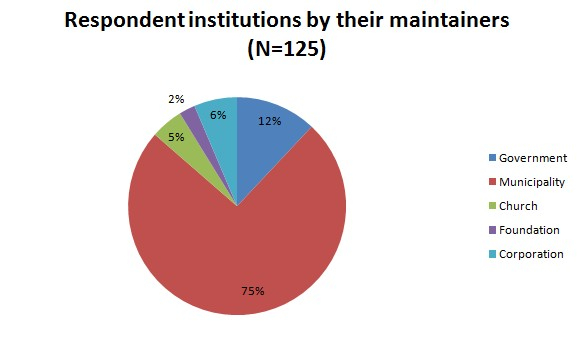
Pic created by Jozsef Antal
The spread between the institutions’ scope of collecting is vast, which means that the issues, challenges and problems each institution faces are also varied. Responders not only include country house museums with small scopes and collections, but also engineering-oriented, contemporary fine art and even relic collections. These (presumably) also reflect the economic, financial and labour requirements of each museum.
The questions of the survey asked about the financial possibilities of the museums, the expected rate of cost increases and what kind of support or guidelines can each of them utilize. Additionally, institutions were also asked about which areas were affected by the energy crisis as of late September, what kind of restrictions are expected in the near future in terms of opening hours, services offered and staff and how does all of the above affect the collections.
There is no dedicated government funding for museums and only two institutions receive municipal funding. There were donations offered by local businesses in the case of one institution, which did ease the burden on both it and its maintainer, even though such funding is not sustainable in the long term. Overall, due to a lack of government support, institutions and their maintainers (municipalities in most cases) can only reduce their increased expenses through restrictions.
The survey asked if museums were aware of any recommendations or guidelines available for the museum sector for energy saving and whether such measures could be applied by them. Three recommendations were proposed for the sector at the time of the survey’s creation, but only a few colleagues were aware of these. These include the proposal made by the Hungarian Institute for Culture, the resolution of the Museum Conservation Committee provided by the Ministry of Culture and Innovation to the maintainers of the institutions via circular and the proposal package of the Association of Hungarian Rural Museums.
Only nine of the institutions were aware of certain recommendations. Seven institutions reported that they developed or plan to develop their own plans, either by themselves or with the involvement of upper management. One institution stated that options are being assessed with the involvement of a professional referent. Although there is a demand for a comprehensive recommendation, previously made ones suggest that, due to the different sizes and needs of individual institutions, the implementation and execution of a uniform strategy would be difficult, if not impossible.
Nearly 60% of the respondents (75 out of a total of 125) stated that negotiations with the maintainers have already begun, however only a few of them could present a proper plan and strategy at the time of the survey. In the case of municipally maintained institutions, often the municipalities themselves do not know what solution would be the most appropriate. In many cases plans were requested from museum management in order to estimate potential municipal costs, however these were rarely followed up by any relevant decision or instruction. In the few instances where this does occur, the maintainer expects some kind of cost mitigation but still provides funds for the operation of the institute and does not take part in the process directly. At the same time, a large portion of the institutions, nearly 30% (37 out of a total of 125) have yet to negotiate with their maintainers. The reasons behind the lack of communication in these cases were not disclosed, or such communication was simply deemed unnecessary. The remaining 10% consists of museums that share their location with another institution, which meant this question was irrelevant for them.
Energy prices, similarly to potential strategies, were merely consulted about during September, which means that only estimates, proposals and preliminary figures are available. The rate and percentage of energy price increases vary greatly depending on the size and maintainer of the given institution.
Out of the 125 answers, 79 provided useful data. The costs of various sub-institutions were evaluated together and some answers only featured increased costs, which insufficient for the calculation of the price increase rates. 44 museums could not provide data on the rate of their cost increases and 15 institutions stated that their costs will not increase.
Based on the data gathered from 79 institutions, the most common price increase is estimated to be between 100 and 1000 percent (in the case 66 institutions). The lowest estimated increase is 15% while the highest is 2000%.
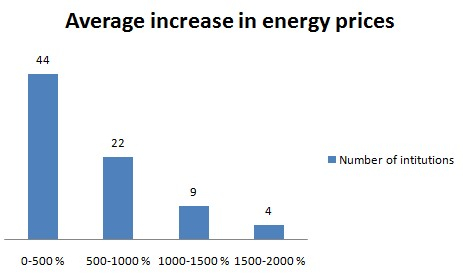
Pic created by Jozsef Antal
Since most institutions have already started negotiations with their maintainers, some of the restrictions that may affect the near future were already identified, however, there is still a lot of uncertainty. At the time of the survey’s deadline (28 September), most institutions did not have to close, reduce opening hours or enforce other restrictions (120 out of 125 institutions stated there were no closures or restrictions by the end of September). Only two institutions have been closed already and three had to reduce opening hours. Most museums are still consulting with their maintainers, therefore in many cases it is unknown what kind of restrictions will be enforced. Based on survey responses, 69 museums do not plan to close for the rest of the year, 29 plan to close and 23 are reducing opening hours.
Despite the lack of recommendations, it appears that all institutions reacted in a similar manner to both restrictions and expectations. The overwhelming majority believes that the limitation or minimization of heating could be the solution for saving costs. More than half of the institutions consider reducing the temperature of office and exhibition spaces to approximately 18-20 degrees Celsius as the most ideal solution to reduce energy usage (much fewer, 36 institutions, also intend on reducing the temperature in collection warehouses). A smaller number of institutions plan on reducing the heating of storage warehouses. In order to further mitigate costs, many institutions plan to minimize or combine office spaces and use air conditioning or infrared panels for heating. A large portion of institutions seek to save costs by changing work hours (either through partial home office or in the form of an on-call system), however, having learned the lessons from 2020, no institution plans to operate completely from home office. The reduction of work hours and the restriction or outright ban of overtime work are also considered.
Apart from the statutory opening hours and services, all institutions aim to reduce their additional services. For example, many are limiting their research services, only offering it at pre-arranged appointments. Several institutions are considering the implementation of a traveling museum service or shifting to content development in order to increase their online presence. Although the reduction of services is a common practice (for example, offering fewer museum education programmes or guided tours), many expressed concern that this may be also perceived as a decline in quality (to offset this, one institution plans to reduce its ticket prices). Nearly 20% of the institutions are planning to reduce opening hours or the number of days they are open, however only partial or minimal closure of exhibition spaces is planned.

Pic created by Anna Tihanyi
One of the survey questions asked about the effects restrictions may have on the artefacts, artworks and collections that are currently part of an exhibition or kept in storage. The replies to this question were varied, with the majority expressing uncertainty or pessimistic views: 35 institutions predicted that damages will be inevitable, while 25 were more optimistic, stating that preservation will still be possible at minimum temperature if humidity levels are maintained. Opinions on the acceptable minimum temperature levels were also divided, ranging between 14 and 5 degrees Celsius.
As several answers have already suggested, not only low temperature, but increased humidity might also present issues in the form of water damage, moulding, the presence of harmful organisms and other unforeseen factors. A few institutions are considering the dismantling of their exhibitions and the relocation of collections to other locations in the future.
By contrast, 28 institutions do not believe that the energy crisis will have a negative effect on cultural assets. These institutions are either used to such conditions (in the case of open air museums) or have collections that are less affected by temperature or humidity.
The survey also asked about the possibilities of shifting to alternative energy management (diversified systems, renewable energy sources, geothermal heating, solar panels, solid fuels). The responses show that apart from a handful of exceptions, the modernisation of museum buildings is hindered by their monument status, heritage protection laws and a general lack of funding (certain institutions have been unable to renovate for 30 years, while others have to store their collection in adobe buildings which are suboptimal in terms of both conservation and operation). Nearly 70% of the respondents lack a proper alternative, however, 7% of the institutions do have access to geothermal energy and an additional 7% are currently in the planning or implementation stages of similar systems. Institutions with building development generally use geothermal energy, solar panels or wood gasification to mitigate energy costs. Museums and institutions without any kind of developments listed the following cost reduction alternatives: changing to LED bulbs, water-saving (with the use of an aerator), heating with air conditioning, using portable heating or infrared panels and reintroducing tiled stoves and solid fuel heating. Although not many institutions had to take extreme measures, there were reports of strict temperature monitoring (including temperature logging, photographic records, reprimands, etc.).
The graph below show the respondents’ opinions on the economic, social and environmental sustainability of the energy crisis. Many consider the situation economically unsustainable for obvious reasons. However the consequences of that might also endanger cultural heritage due to the deterioration of artefacts and the decrease in services, visitors, exhibitions and museum education activities. The graph also shows that there is an environmental concern, but it is considered somewhat less problematic, which can be attributed to general notion of cost saving as well as the shift towards sustainable alternative fuel sources.
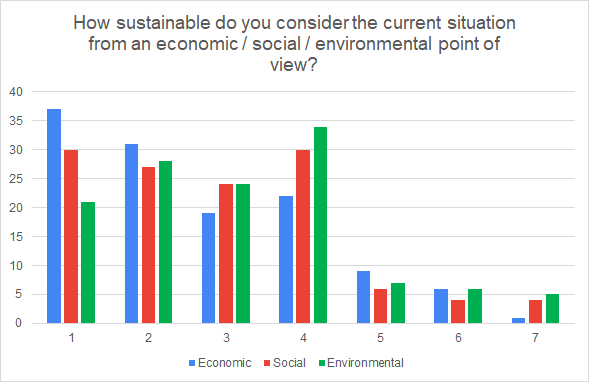
Pic created by Anna Tihanyi
Overall, the survey responses show that while only a few institutions have concrete plans or know about recommendations, the reaction was identical nationwide: every institution is trying to cut back and save on all possible expenses, even though the rate of cost increases are still unknown. One thing is certain, this heating season will be a learning experience for all museums.
Written by: Regina Kalló, Anna Tihanyi
Analysis, graphs: József Antal
Translation: Csaba Medve